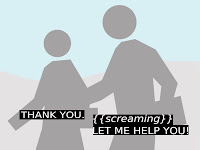
I'm a reluctant user of closed captioning now. I've always been deaf in my left ear, but had good enough hearing in my right that I could hear television. But, as my children have pointed out, in recent months I have had the volume turned up loudly enough for our next door neighbors to hear what we are watching. So, I have turned on closed captioning.
It seems as if there are two type of captioning. With one type it seems the captioners (is that what they are called?) have been given a script ahead of time and have entered the captioning. That kind of captioning follows closely with the spoken word - not much of a delay. The second type seems to be 'live' captioning - in other words, the captioners are entering the words just as they are spoken. There is, of course, a delay with this type. But with both types, there are so many errors that it is often difficult to follow along with the TV show.
I can understand to a degree the errors in live captioning, although I would prefer a lot less. But, it's tough to understand errors when the captioners have the scripts ahead of time.
Maybe I just don't know enough about captioning, but so far, it has not been a great experience. So much of the actual show is missed or misinterpreted. I'm really disappointed. So much for universal access.
4 comments:
Captioning is tricky. I don't know a lot about it, but I know a little from a friend who has worked in captioning. For live shows, the encoding is done by a speaker speaking into a device that phonetically translates voice to text. Lots of room for error as we may be familiar with from those annoying voice-recognition phone menus.
There is also a difference between subtitles and captioning. Subtitles assume the viewer can hear, but cannot understand what is being said. It is a transliteration. Captions assume the viewer cannot hear, and will translate (note my choice of transliterate and translate) spoken word, background noises, and other sounds. Since captioning is geared to viewers who cannot hear the speech, it is able to cut out the "non-essential" words that decorate our language, but may confuse say, and ASL user or Signer.
That's all I think I know. ;)
The Closed Captioning is on at our house all the time (my ds is HOH), and I've noticed the same issues. Sometimes even with the misspellings, the conversations make sense--but often not. It is frustrating to me, and I am hearing! I can't imagine what it's like for people Deaf/HOH.
There will be times when maybe the caption on the TV doesn't match the spoken sentence at all. That is because some phrases don't exist in ASL (American Sign Language), so it has to be edited to make sense to the Deaf community.
Sange
I have noticed the SAME thing! I use the captioning when I am with my kids sometimes...I just can't hear what is on the tv because THEY are so loud!
But I've noticed that when reading something that I can also hear, the errors are really bad.
That's disappointing about Closed Captioning! I haven't tried it yet, but I do always use subtitles when watching movies. I didn't realize my hearing was becoming poorer until I had to keep asking the family to "turn up the TV" and I'd get shocked looks from them like "you can't hear that?!!".
Thanks mommy~dearest for the great explanation about captioning vs. subtitles :-)
Post a Comment